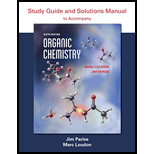
Concept explainers
(a)
Interpretation:
Whether two enantiomers of
Concept introduction:
When two molecules consist of the same atoms which are linked in the same sequence, but the atoms are placed differently in space, then they are called the stereoisomers.
The organic compounds that are found to be non-superimposable on their mirror images are called as enantiomers. Enantiomer of a compound has opposite configuration.
(b)
Interpretation:
Whether two enantiomers of
Concept introduction:
When two molecules consist of the same atoms which are linked in the same sequence, but the atoms are placed differently in space, then they are called the stereoisomers.
The organic compounds that are found to be non-superimposable on their mirror images are called as enantiomers. Enantiomer of a compound has opposite configuration.
(c)
Interpretation:
Whether two enantiomers of
Concept introduction:
When two molecules consist of the same atoms which are linked in the same sequence, but the atoms are placed differently in space, then they are called the stereoisomers.
The organic compounds that are found to be non-superimposable on their mirror images are called as enantiomers. Enantiomer of a compound has opposite configuration.
(d)
Interpretation:
Whether two enantiomers of
Concept introduction:
When two molecules consist of the same atoms which are linked in the same sequence, but the atoms are placed differently in space, then they are called the stereoisomers.
The organic compounds that are found to be non-superimposable on their mirror images are called as enantiomers. Enantiomer of a compound has opposite configuration.
(e)
Interpretation:
Whether two enantiomers of
Concept introduction:
When two molecules consist of the same atoms which are linked in the same sequence, but the atoms are placed differently in space, then they are called the stereoisomers.
The organic compounds that are found to be non-superimposable on their mirror images are called as enantiomers. Enantiomer of a compound has opposite configuration.
(f)
Interpretation:
Whether two enantiomers of
Concept introduction:
When two molecules consist of the same atoms which are linked in the same sequence, but the atoms are placed differently in space, then they are called the stereoisomers.
The organic compounds that are found to be non-superimposable on their mirror images are called as enantiomers. Enantiomer of a compound has opposite configuration.
(g)
Interpretation:
Whether two enantiomers of
Concept introduction:
When two molecules consist of the same atoms which are linked in the same sequence, but the atoms are placed differently in space, then they are called the stereoisomers.
The organic compounds that are found to be non-superimposable on their mirror images are called as enantiomers. Enantiomer of a compound has opposite configuration.
Want to see the full answer?
Check out a sample textbook solution
Chapter 7 Solutions
Organic Chemistry Study Guide and Solutions
- What is the name of the following compound? SiMe3arrow_forwardK Draw the starting structure that would lead to the major product shown under the provided conditions. Drawing 1. NaNH2 2. PhCH2Br 4 57°F Sunny Q Searcharrow_forward7 Draw the starting alkyl bromide that would produce this alkyne under these conditions. F Drawing 1. NaNH2, A 2. H3O+ £ 4 Temps to rise Tomorrow Q Search H2arrow_forward
 ChemistryChemistryISBN:9781305957404Author:Steven S. Zumdahl, Susan A. Zumdahl, Donald J. DeCostePublisher:Cengage Learning
ChemistryChemistryISBN:9781305957404Author:Steven S. Zumdahl, Susan A. Zumdahl, Donald J. DeCostePublisher:Cengage Learning ChemistryChemistryISBN:9781259911156Author:Raymond Chang Dr., Jason Overby ProfessorPublisher:McGraw-Hill Education
ChemistryChemistryISBN:9781259911156Author:Raymond Chang Dr., Jason Overby ProfessorPublisher:McGraw-Hill Education Principles of Instrumental AnalysisChemistryISBN:9781305577213Author:Douglas A. Skoog, F. James Holler, Stanley R. CrouchPublisher:Cengage Learning
Principles of Instrumental AnalysisChemistryISBN:9781305577213Author:Douglas A. Skoog, F. James Holler, Stanley R. CrouchPublisher:Cengage Learning Organic ChemistryChemistryISBN:9780078021558Author:Janice Gorzynski Smith Dr.Publisher:McGraw-Hill Education
Organic ChemistryChemistryISBN:9780078021558Author:Janice Gorzynski Smith Dr.Publisher:McGraw-Hill Education Chemistry: Principles and ReactionsChemistryISBN:9781305079373Author:William L. Masterton, Cecile N. HurleyPublisher:Cengage Learning
Chemistry: Principles and ReactionsChemistryISBN:9781305079373Author:William L. Masterton, Cecile N. HurleyPublisher:Cengage Learning Elementary Principles of Chemical Processes, Bind...ChemistryISBN:9781118431221Author:Richard M. Felder, Ronald W. Rousseau, Lisa G. BullardPublisher:WILEY
Elementary Principles of Chemical Processes, Bind...ChemistryISBN:9781118431221Author:Richard M. Felder, Ronald W. Rousseau, Lisa G. BullardPublisher:WILEY





